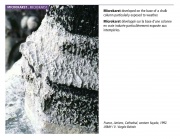Difference between revisions of "Karst"
Jump to navigation
Jump to search
(username removed) |
|||
| Line 2: | Line 2: | ||
== Description == | == Description == | ||
| − | A topographic term for the landscape and structures formed in soluble bedrock by the effects of solution weathering. Karst regions are characterized by subterranean caverns, sinkholes, and dolines. Karst typically results from the action of mildly acidic water percolating through [ | + | A topographic term for the landscape and structures formed in soluble bedrock by the effects of solution weathering. Karst regions are characterized by subterranean caverns, sinkholes, and dolines. Karst typically results from the action of mildly acidic water percolating through [[limestone]], [[gypsum]], or [[dolomite]]. As the rock dissolves, it becomes more porous and underground drainage systems develop. |
[[File:Microkarst-02_ICOMOS.jpg|thumb|Microkarst]] | [[File:Microkarst-02_ICOMOS.jpg|thumb|Microkarst]] | ||
| + | |||
== Synonyms and Related Terms == | == Synonyms and Related Terms == | ||
Revision as of 09:33, 21 January 2014
Description
A topographic term for the landscape and structures formed in soluble bedrock by the effects of solution weathering. Karst regions are characterized by subterranean caverns, sinkholes, and dolines. Karst typically results from the action of mildly acidic water percolating through Limestone, Gypsum, or Dolomite. As the rock dissolves, it becomes more porous and underground drainage systems develop.
Synonyms and Related Terms
karst (Fr., Port.); carso (Port.)
Authority
- Submitted information Comment: José Delgado Rodrigues, LNEC, 2009.
- Wikipedia, the free encyclopedia, at http://www.wikipedia.com Comment: Karts topography (accessed March 2010)

